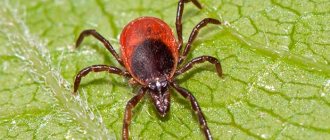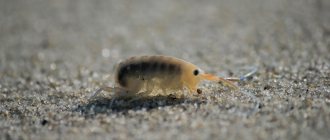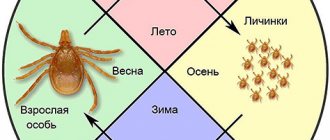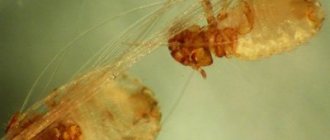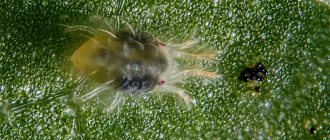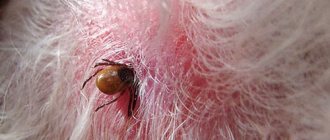Ticks in September and other autumn months. The phases of greatest activity of parasites, when they are most aggressive and dangerous. What dangerous diseases are carried? What symptoms should you pay attention to? How to remove an attached tick yourself. Possible methods of protection against ticks.
Many people believe that ticks are most dangerous in the spring, with the arrival of warmer weather, and during the rest of the period they do not pose a great danger. This opinion is erroneous because these parasites have two active seasons, the first is spring, the second is autumn.
If we talk about the threat they pose to humans and animals, ticks in September are just as dangerous as at any other time, since they are carriers of infection regardless of the season. Next, we will take a closer look at the active seasons, find out whether they are aggressive in the fall, what danger they pose and how to protect yourself from them.
Seasons of activity
If we talk about the seasonality of these parasites, it will be easier to determine the period when they are not active. After all, they are very tenacious and easily tolerate any climatic conditions if the air temperature rises above 6-8°C. The only climatic conditions under which they cannot lead an active lifestyle are frosts.
With the onset of frost, they go into a period of hibernation, fall asleep and disappear, and with the arrival of the first warmth they go through the following phases of activity:
- April May. The first phase of activity falls during this period. No one can say exactly when the seasonality of parasites will begin, since this is directly related to climatic conditions and temperature conditions. They wake up from winter sleep at an air temperature of 6-8°C. It is during this period that they are considered the most aggressive, since they are hungry and require nutrition for development and reproduction.
- June August. From the second half or end of June until August, a decrease in activity is observed. This is due to a period of temporary physiological rest, but at this time they can also attack people and animals, just in much smaller numbers.
- September October. The second phase of activity, when ticks become as aggressive as during the first phase. This is due to the fact that they require complete saturation in order to easily endure hibernation.
Tick activity in August and September
An important condition for the existence of ticks is the presence of optimal humidity. Excessively dry or too humid places are not to their liking. Hungry female ticks are active until June. The period of diapause (temporary physiological rest) begins from late June to early August. Already at the end of August and the beginning of September there is a new round of activity of ticks, which in the first half of summer did not have time to feed and leave offspring. The answer to the question of whether there are ticks in August is clear - yes, they exist and are quite active.
The population size and activity of ticks in autumn is influenced by human activity. Foci of encephalitis exist due to ticks, which parasitize animals and transmit the virus. Measures to combat vectors in forests are carried out in early spring, immediately after the snow melts. Ticks that survive after processing forests look for food even more actively in the fall. Where such treatment is not carried out, there are especially many ticks.
An increase in the number of ticks in autumn may be related to the weather. Mild winters and early springs, high humidity and cool weather in summer allow ticks to overwinter well and reproduce in more favorable conditions. If Indian summer begins at the end of October, the activity of ticks does not subside. Until the first cold weather, they will search for their prey. And only when the thermometer drops to 5 degrees do ticks go into hibernation.
Appearance
These parasites belong to the group of arthropods, of which there are about 40 thousand species. Among them are ixodid parasites, whose diet consists of human and animal blood. Depending on the species, ticks can have different body sizes from 3 to 25 mm. The shape of the body is elongated and flattened, consists of a torso and head, and has fragments of elastic and hard tissue.
They have a piercing-sucking mouthparts, which they use to puncture the skin and stick to a blood vessel with their proboscis. The length of the proboscis may differ among individuals of different species.
They do not have organs of vision, but the absence of eyes does not at all prevent them from perfectly orienting themselves in space and easily finding food sources. The fact is that they have well-developed sensitive receptors, which replace the function of vision.
The body is covered with a kind of shield that protects the body from damage. In females it is small in size and covers only part of the body, while in males it covers completely.
They have 4 pairs of legs, each with a suction cup and claws, which allow the tick to hold firmly on any surface. Females always have larger body sizes than males, they also differ in color, the female has a brown tint, and the male is brown.
When saturated with blood, the parasites increase significantly in size; one individual can suck twice as much blood as it weighs. During saturation, the shape of the body changes, they become oval, and the color also changes to red.
Periods of maximum tick activity
For those who are interested in when the tick season begins and ends, the answer is from April to October. With the onset of cold days, insects hibernate. They wake up in early spring. During the spring period when ticks are active, insects are the most aggressive, and therefore dangerous.
Having emerged from hibernation, they begin to intensively search for warm blood, without which it is difficult for them to wake up and begin to reproduce. Insects feed on the blood of both animals and humans.
A table of tick activity by month is presented below.
| Month | Activity | Note |
| April | 100% | Extremely aggressive. They bite hard and often because they are hungry |
| May | 98% | |
| June | 87% | |
| July | 75% | Moderately active |
| August | 85% | |
| September | 92% | Extremely aggressive. Eating before hibernation |
| October | 97-100% |
As can be seen from the table of tick activity by month in the Moscow region, insects show maximum aggression in those seasons when wet weather prevails. They feel great in shaded and moist deciduous and mixed forests. They thrive in thick grass and willow. Therefore, ticks in September and early spring are localized:
- in windbreaks;
- on the banks of rivers and the bottom of ravines;
- along forest paths overgrown with thick grass;
- on forest edges and parks.
But in fact, you can “catch” parasites anywhere during the periods when ticks are active - mid-April to mid-late October. Many contemporaries suggest that insects fall on them from the branches of trees and bushes. But this opinion is wrong. Hiding in the thickets, blood-sucking parasites literally rush at the victim who is nearby. They:
- from the first frost, when ticks cease to be active, they begin to actively hide in secluded places, preparing for hibernation;
- afraid of direct sunlight;
- love ambient temperatures up to 210C (forest cool);
- When the tick season begins, they bite very painfully, biting through a fairly large wound on the skin.
We have found out in what month and when exactly ticks are active, now we will find out how dangerous they are for animals and humans.
How dangerous are blood-sucking insects?
We have already found out that ticks are quite active in the Moscow region in September. Moreover, they are aggressive because they are preparing for hibernation. Their bites are unpleasant and dangerous for two reasons:
- Insects are carriers of viruses. Depending on the location of the parasite and its variety, it can cause infection of a healthy body with various viral infections - borreliosis, typhus and tick-borne relapsing fever, encephalitis, Crimean fever (hemorrhagic), babesiosis, spotted fever, etc. Answering the question, are they dangerous? ticks in the fall for humans, let's say yes.
- Insects can cause various diseases. It is quite difficult to remove a parasite that has been absorbed into the skin. Especially when a person starts to panic. In 7 out of 10 cases, the head remains in the wound, which becomes the cause of pustular lesions. Forest ticks in the fall are dangerous due to irritation and allergic reactions.
Young children and people with allergies can be significantly harmed by the bite of a single blood-sucking insect. The area of skin lesions can reach 1 cm or more.
Therefore, the question of whether ticks are dangerous in September in the Moscow region is as relevant as the question of the danger of insects in the spring-summer season. More often parasites transmit encephalitis. This is a very severe and fast-acting disease of viral etiology.
It affects the nervous system of a person or animal. The main complication of untimely treatment is irreversible changes in the brain. Therefore, you should be concerned not about whether there are ticks in September, but what they look like, how to get rid of them and protect yourself.
Let's look at these problems in more detail.
What does a blood-sucking parasite look like?
Having found out whether there are ticks in the Moscow region in September, we will learn to recognize the “enemy”. The insect has an arachnid appearance and a strongly flattened body 3-25 mm long and weighing 3-4 mg. The size of the body depends on the species. Moreover, females of all morphotypes are significantly larger than males.
During the active period of ticks, insects drink several times their body weight in blood. Their body spreads out in width, acquiring an ovoid shape. After feeding, the weight of the parasite can reach 40-500 mg. By the time tick season ends, the ticks look like the photo below.
Features of the body structure of the parasite:
- sharp trunk;
- organs of vision are absent. Instead, insects have well-developed receptors. During the active season of ticks, it is with their help that the blood-sucking parasite catches the smell of warm blood;
- four pairs of tenacious and mobile limbs;
- the claws on the feet have webbed suckers. During tick activity, the suckers help to stay on the victim's body;
- limbs consist of six segments;
- the respiratory plates are located at the back (behind the fourth pair of limbs);
- dorsal shield protecting the head.
Once again we will answer the question of whether there are ticks in the fall that suck blood and carry viral diseases. Yes, there are, and they are very active.
Therefore, experts recommend checking the skin for the presence of embedded parasites after every walk in the forest or in tall grass. The external characteristics of arthropod insects are described above.
The color of the cover ranges from light brown and brownish-red to black. After eating, the body color is dark gray. Remember: ticks are present in the fall and they are just as active and dangerous as in the spring.
Symptoms of encephalitis after a tick bite
An interesting fact is that only females suck blood. At the same time, they can increase in size by 100 times. Nature endowed them with a more protective cover and tenacity.
Female ticks in August or April (the season is not important) quickly move through the grass and clothing to unprotected areas of the skin. Here they can sit and absorb blood for up to 10 days.
Scientists know that male ticks were also active in September, but their presence on the victim was short-lived. The fact is that they are not adapted to suck blood for a long time.
Since females need to feed in order to give birth, the answer to the question of whether there are ticks in August is yes. They imperceptibly dig into the skin, making a large bite (relative to their body size). At this point, their salivary glands secrete a strong anesthetic substance.
Because of it, in the first few minutes the victim does not feel pain, allowing the female to dig into the skin. Are ticks really that dangerous in September or any other month of the active period? Dangerous if infected with viruses. Pathogenic organisms are contained in insect saliva.
Therefore, at the moment of the bite, infection occurs.
Symptoms of tick-borne encephalitis are as follows:
- increased body temperature;
- severe drowsiness and fatigue;
- increased weakness;
- increased sweating even during periods of inactivity.
When figuring out whether ticks are dangerous in the fall and spring-summer period, remember that experts have calculated that only 5-9% of blood-sucking insects are infected with encephalitis and other viruses.
But despite the low probability of contracting serious illnesses, it is worth protecting yourself from ticks in August, because they are dangerous and cause unpleasant skin lesions and allergies.
How to protect yourself from tick bites?
During the period when ticks disappear from the forest, additional skin protection is not needed. Insects hide and fall asleep. Therefore, before you go for a walk, find out whether there are currently ticks in the thickets and forest. If they are active then:
- Wear clothes made of thick fabrics with long legs and sleeves.
- Wear a hat.
- Wear tight-fitting shoes. To find out whether there are ticks in the forest now, you don’t have to ask a specialist. Just look at the thermometer. If the temperature
- Tuck your trouser legs into your socks.
- Choose a shirt with thick cuffs.
- Treat bare areas of the body and clothing adjacent to them with special compounds.
If you are wondering whether ticks are dangerous for people in August because you plan to be a frequent visitor to the forest belt, then it makes sense to get vaccinated against encephalitis. Otherwise, doctors recommend not to neglect the use of repellents.
Having decided how dangerous ticks are in August, take on board several effective drugs - “Tornado-anti-tick”, “Permanon”, “Tick-kaput aerosol” and others. Some drugs kill parasites, others repel them, and others have a combined effect. The choice is up to you.
The main thing is not to neglect them during the period when ticks are active in August and September. And if you notice redness in the affected area and rapid fatigue, consult a doctor immediately.
What danger do they pose to humans?
Regardless of when exactly the tick attacks, in September or May, there is always the possibility of infection with dangerous diseases. These individuals are carriers of diseases such as encephalitis, borreliosis, fever, typhus and others. Of course, not all individuals are infected and carry the virus, but absolutely all can cause a number of other problems.
An insect bite can cause inflammation, irritation, and allergic reactions. There is always a risk of germs and bacteria getting into the wound, which will cause the wound to fester.
Also, if a blood-sucking substance is found on the body, you need to go to the hospital so that the doctor can remove it correctly. When removing an attached parasite yourself, there is always a risk of making mistakes. Fragments of insects may remain in the wound, infection may occur, etc.
Ticks in winter
So, when the temperature of the earth's surface drops below 5 degrees, ticks freeze and fall into winter torpor. People stop treating their dogs against ticks and become less vigilant.
However, we can relax only if the temperature outside is consistently low, below -5 degrees, and the ground is covered with a thick layer of snow.
But a dog has a risk of “catching” a tick even in winter! Let's look at the most typical options
Sources
- https://VreditelNet.ru/kleshhi-v-sentyabre-opasny-ili-net.html
- https://Dezoff.ru/kleshhej/kleshchi-v-2020/
- https://moscow-777.ru/prochee/kogda-snizhaetsya-aktivnost-kleshhej.html
- https://nithome.ru/kleshhi/est-li-kleshi-v-sentyabre.html
- https://KlopVred.ru/kleshhi/kleshhi-v-sentyabre/
- https://vreditel-stoi.ru/kleshhi/kleshhi-osenyu.html
- https://TaraKlop.ru/kleshchi/sezon-aktivnosti-kleshhey/
- https://nzs-rst.ru/kleshchi/v-noyabre-byvayut.html
[collapse]
What places to avoid
Unfortunately, there are simply no places where complete safety from these parasites is guaranteed. Regardless of whether you are going on vacation to the Moscow region or another region, during periods of activity they can be found in absolutely any territory.
There are some weather conditions that are not entirely suitable for them, such as dry and hot weather. Then they prefer to hide in shaded places where humidity is maintained. Large populations are found in deciduous and mixed forests; there are more favorable conditions for development and reproduction.
Regarding places that are best avoided in September and other warm periods, these include tall grass, shaded areas, willow trees, lake and river banks, and ditches. Of course, they can also be found in urban environments, especially parks. There is an opinion that parasites attack people by jumping from trees; these assumptions are misleading.
The fact is that these insects cannot tolerate direct sunlight, the ideal temperature is up to 21°C and necessarily high humidity. There are no favorable conditions for them at the tops of trees. In addition, these small parasites move very slowly and cannot cover long distances, and climbing to the top of a tree is not an easy task.
They are quite intelligent and hide in the grass and bushes near animal trails, where prey often passes and is easy to attack. In urban environments, they attack dogs and cats from the grass, and if a person passes, they cling to the legs and crawl upward to find a place to bite.
Methods of protection against ticks
The best way to protect yourself from blood-sucking parasites is not to go into the forest and spend the period of tick activity at home. This, of course, is not an option. Therefore, you need to prepare in other ways:
- clothing should be tight and closed;
- pants should be chosen with elastic at the calves so that the tick cannot crawl further;
- the jacket should be thick, also preferably with an elastic band at the wrists;
- shoes - high and closed.
Another important point is that you need to constantly inspect your clothing for ticks already attached. They are more visible on light-colored clothes, so it is recommended to choose a wardrobe in light colors.
Avoid wandering into dense grassy areas and stick to well-trodden paths and paths.
Precautions against tick bites
Infection with dangerous diseases
The attack of females and males is different. Thus, a female can remain on the victim for up to 10 days and be saturated with blood all this time. She needs more food so that she can lay offspring.
Males attached to the body are more difficult to detect, since they quickly bite, gorge themselves and fall off on their own. When a tick falls on a person, it can crawl over the body for 2 hours to find a suitable place to bite. They look for areas where the skin is most delicate and where blood vessels are located closely.
They often choose places on the neck, behind the ears, under the arms, under the chest, near the shoulder blades, and the groin area, but they can also be found in other areas. The bite itself occurs as follows: the individual pierces the skin, while releasing an anesthetic enzyme, which is why they cannot be detected at this stage.
Next, they insert a proboscis into the wound and firmly attach themselves to the blood vessel. The infection virus is contained in saliva and products of the gastrointestinal tract; infection can occur immediately after a parasite bite.
How to dress for a walk in nature in September
The first rule is that clothes must be closed. Pants should be tucked into socks; bell-bottoms should not be worn. You should choose a jacket with long sleeves. It is necessary to exclude clothes with cutouts and buttons. If you have long hair, then you need to collect it. We must not forget about the hat even when it is warm, as a means of protection it is necessary. High rubber boots and insect netting are required.
What should behavior be like in the forest in autumn:
- Do not climb into tall bushes and grass unless necessary;
- you should walk along well-trodden paths;
- avoid dry tall grass as a possible place for ticks to accumulate;
- visit the forest during the day, avoiding morning and evening hours.
After arriving home, it is necessary to examine the body for the presence of attached ticks. In women, parasites often target the chest and neck; in men, the groin area and armpits. This is due to the insects’ instinct for warm places well supplied with blood. Clothes should be shaken and hair should be combed with a fine comb.
Tick-borne encephalitis
Once in the body, the infection goes through an incubation period, after which the first symptoms of the disease appear. The period for symptoms to appear may vary; after an encephalitis tick bite, it can take from 3 days to 3 months until signs of infection begin to appear.
They are very similar to the symptoms of a cold or flu, so it is very important to remember the attack and consult a doctor immediately.
A person feels severe weakness, body temperature rises, headaches, joint aches, and drowsiness begin. Then the symptoms disappear for a while, and if a person took cold medicine, he thinks that he has simply been cured.
But in fact, the virus attacks the nervous system and brain. This leads to paralysis of the limbs and impaired motor activity. The disease can lead to decreased mental activity, muscle atrophy, and in severe cases, death.
Are ticks dangerous in the fall?
In addition to the risk of becoming infected with the dangerous encephalitis virus, there are other dangers. The tick is capable of suppressing the human immune system, which leads to the possibility of contracting additional infections. Already in the first minutes after the bite, the virus enters the bloodstream, so with the arrival of autumn there is no need to relax. Tick activity in autumn is less pronounced than in spring, but being bitten in autumn is no less dangerous than in spring or summer. Low temperatures above zero are not scary for ticks. Even after night frosts, when the sun warms up, the warmth will be enough for them to resume their activity.
In summer, female ticks lay eggs, which turn into larvae a month later. The larvae feed on the blood of small animals such as mice and birds. Having had enough, they fall off, climb into the forest humus, molt and transform into nymphs. Nymphs after hibernation look for larger prey; they drink blood from forest inhabitants such as foxes or raccoons. Having received the necessary portion of blood, they hibernate, and only the next year the nymph transforms into an adult (female or male).
Females are much larger than males; they need to be saturated with blood for about 6–7 days. The volume of blood consumed is one hundred times the weight of the individual itself. Male ticks need much less time to satiate. Their main concern is finding females to mate with. Unlike forest mosquitoes and midges, the tick acts unnoticed. Its bite cannot be felt. It is the fully formed tick, to which the virus has passed from small rodents at the larval and nymph stages, that is most dangerous to humans as a carrier of infection.
Tick-borne borreliosis
With this disease, external symptoms appear, in which the site of the attack turns red, a clear outline appears, and swelling appears. Then the redness subsides, the spot becomes pale and a bluish tint appears.
The first symptoms may appear after 30 days. External symptoms disappear after 2 weeks. Next, the virus begins to infect the brain, cardiovascular system, and blood vessels. The virus can remain in the body for 2-3 years and not make itself felt, causing irreparable consequences.
When the danger is especially great
There are certain periods during which tick activity is pronounced:
- from April to June;
- from August to October.
The first tick season begins in the spring, when the air temperature warms up to approximately +10 degrees.
An adult bloodsucker is dangerous at any time of the year, but especially in spring and autumn
They come out of their sleepy state and wait for the right opportunity to get enough. This period of activity will last until mid-June. After this there will be a pause. The second wave of tick activity will begin from the end of August. Its duration depends on the weather conditions. If the autumn season turns out to be warm, then ticks in October will pose no less danger than in May.
How to remove a stuck tick
If you have the opportunity to go to a medical facility, you should definitely do so. But if this is not possible, you can carry out the procedure yourself. To do this, you can use tweezers, thread, or special devices that can be purchased at the pharmacy.
Remember that the main thing is to correctly capture the parasite body. It is necessary to fix the parasite as close to the skin as possible in order to hold not only the abdomen, but also the head. Next, you should unscrew the parasite and pull it up a little. You should not make sudden movements, tear it out of the wound, or apply too much pressure; all this can lead to rupture of the parasite and increase the likelihood of infection.
There are situations when the removal is carried out incorrectly and the head or other fragments of an insect remain in the wound; they must be removed, otherwise inflammation and rotting of the wound will begin. To do this, a needle is used; it must be picked up with the remaining particle. If it is deep in the wound, it is necessary to go to the hospital.
The insect that was managed to be removed from the wound must be placed in a jar and submitted for analysis to a laboratory, where research will be carried out and the results will show whether the tick is infected. This will allow you to use the correct treatment in the early stages and prevent complications.
How to get rid of a parasite
To remove an insect without health consequences, it is better to seek help from a doctor. If this is not possible, it is removed as follows:
- The tick is grasped with your fingers at the place where the head connects to the skin. Then unscrew it like a screw clockwise.
- It is recommended to do unscrewing with tweezers and not with your hands, otherwise there is a chance of crushing the insect, which will lead to suppuration of the wound or infection. The tweezers should not be placed perpendicular to the skin or at an angle. Parallel placement is considered correct.
- Sometimes when the parasite is removed, the proboscis remains in the wound. The body will push it out on its own, so you should not take any action to eliminate it.
- After removing the insect, the wound is treated with an antiseptic. Hands are thoroughly washed with laundry soap.
- The tick is placed in a jar, tightly closed with a lid, and taken for examination.
Note! To get the tick out on its own, some people pour kerosene or sunflower oil on it. You should not use this method. These substances block the insect's access to oxygen; before crawling out, it regurgitates back all the pumped blood along with saliva, which is contaminated with infections.

